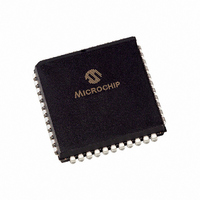PIC18F452-I/LG Microchip Technology, PIC18F452-I/LG Datasheet - Page 73

PIC18F452-I/LG
Manufacturer Part Number
PIC18F452-I/LG
Description
IC MCU FLASH 16KX16 W/AD 44PLCC
Manufacturer
Microchip Technology
Series
PIC® 18Fr
Datasheets
1.PIC16F616T-ISL.pdf
(8 pages)
2.PIC18F242-ISO.pdf
(332 pages)
3.PIC18F242-ISO.pdf
(14 pages)
4.PIC18F242-ISO.pdf
(16 pages)
5.PIC18F242-ISO.pdf
(16 pages)
6.PIC18F242-ISO.pdf
(14 pages)
7.PIC18LF242-ISO.pdf
(36 pages)
Specifications of PIC18F452-I/LG
Core Processor
PIC
Core Size
8-Bit
Speed
40MHz
Connectivity
I²C, SPI, UART/USART
Peripherals
Brown-out Detect/Reset, LVD, POR, PWM, WDT
Number Of I /o
34
Program Memory Size
32KB (16K x 16)
Program Memory Type
FLASH
Eeprom Size
256 x 8
Ram Size
1.5K x 8
Voltage - Supply (vcc/vdd)
4.2 V ~ 5.5 V
Data Converters
A/D 8x10b
Oscillator Type
External
Operating Temperature
-40°C ~ 85°C
Package / Case
44-PLCC
For Use With
XLT44L2 - SOCKET TRAN ICE 44PLCCDVA16XL441 - ADAPTER DEVICE ICE 44PLCC
Lead Free Status / RoHS Status
Lead free / RoHS Compliant
- PIC16F616T-ISL PDF datasheet
- PIC18F242-ISO PDF datasheet #2
- PIC18F242-ISO PDF datasheet #3
- PIC18F242-ISO PDF datasheet #4
- PIC18F242-ISO PDF datasheet #5
- PIC18F242-ISO PDF datasheet #6
- PIC18LF242-ISO PDF datasheet #7
- Current page: 73 of 332
- Download datasheet (6Mb)
7.0
7.1
An 8 x 8 hardware multiplier is included in the ALU of
the PIC18FXX2 devices. By making the multiply a
hardware operation, it completes in a single instruction
cycle. This is an unsigned multiply that gives a 16-bit
result. The result is stored into the 16-bit product regis-
ter pair (PRODH:PRODL). The multiplier does not
affect any flags in the ALUSTA register.
TABLE 7-1:
7.2
Example 7-1 shows the sequence to do an 8 x 8
unsigned multiply. Only one instruction is required
when one argument of the multiply is already loaded in
the WREG register.
Example 7-2 shows the sequence to do an 8 x 8 signed
multiply. To account for the sign bits of the arguments,
each argument’s Most Significant bit (MSb) is tested
and the appropriate subtractions are done.
EXAMPLE 7-1:
© 2006 Microchip Technology Inc.
MOVF
MULWF
16 x 16 unsigned
8 x 8 unsigned
16 x 16 signed
8 x 8 signed
Routine
8 X 8 HARDWARE MULTIPLIER
Introduction
Operation
ARG1, W
ARG2
PERFORMANCE COMPARISON
8 x 8 UNSIGNED
MULTIPLY ROUTINE
Without hardware multiply
Without hardware multiply
Without hardware multiply
Without hardware multiply
;
; ARG1 * ARG2 ->
;
Hardware multiply
Hardware multiply
Hardware multiply
Hardware multiply
Multiply Method
PRODH:PRODL
Program
Memory
(Words)
13
33
21
24
52
36
1
6
Making the 8 x 8 multiplier execute in a single cycle
gives the following advantages:
• Higher computational throughput
• Reduces code size requirements for multiply
The performance increase allows the device to be used
in applications previously reserved for Digital Signal
Processors.
Table 7-1 shows a performance comparison between
enhanced devices using the single cycle hardware mul-
tiply, and performing the same function without the
hardware multiply.
EXAMPLE 7-2:
Example 7-3 shows the sequence to do a 16 x 16
unsigned multiply. Equation 7-1 shows the algorithm
that is used. The 32-bit result is stored in four registers,
RES3:RES0.
EQUATION 7-1:
RES3:RES0
MOVF
MULWF
BTFSC
SUBWF
MOVF
BTFSC
SUBWF
algorithms
Cycles
(Max)
242
254
91
36
69
24
1
6
ARG1,
ARG2
ARG2,
PRODH, F
ARG2,
ARG1,
PRODH, F
=
=
@ 40 MHz
24.2 s
25.4 s
100 ns
600 ns
6.9 s
9.1 s
2.4 s
3.6 s
ARG1H:ARG1L ARG2H:ARG2L
(ARG1H ARG2H 2
(ARG1H ARG2L 2
(ARG1L ARG2H 2
(ARG1L ARG2L)
SB
SB
W
W
8 x 8 SIGNED MULTIPLY
ROUTINE
16 x 16 UNSIGNED
MULTIPLICATION
ALGORITHM
PIC18FXX2
; ARG1 * ARG2 ->
; PRODH:PRODL
; Test Sign Bit
; PRODH = PRODH
;
; Test Sign Bit
; PRODH = PRODH
;
@ 10 MHz
102.6 s
27.6 s
36.4 s
96.8 s
14.4 s
400 ns
Time
9.6 s
2.4 s
DS39564C-page 71
- ARG1
8
8
16
- ARG2
) +
) +
) +
@ 4 MHz
242 s
254 s
69 s
91 s
24 s
36 s
1 s
6 s
Related parts for PIC18F452-I/LG
Image
Part Number
Description
Manufacturer
Datasheet
Request
R

Part Number:
Description:
Manufacturer:
Microchip Technology Inc.
Datasheet:

Part Number:
Description:
IC MCU FLASH 16KX16 EE 40DIP
Manufacturer:
Microchip Technology
Datasheet:

Part Number:
Description:
IC MCU FLASH 16KX16 EE 44PLCC
Manufacturer:
Microchip Technology
Datasheet:

Part Number:
Description:
IC MCU FLASH 16KX16 EE 44TQFP
Manufacturer:
Microchip Technology
Datasheet:

Part Number:
Description:
IC MCU FLASH 16KX16 A/D 44QFN
Manufacturer:
Microchip Technology
Datasheet:

Part Number:
Description:
IC MCU CMOS 40MHZ 16K FLSH44TQFP
Manufacturer:
Microchip Technology
Datasheet:

Part Number:
Description:
IC MCU FLASH 16KX16 W/AD 40DIP
Manufacturer:
Microchip Technology
Datasheet:

Part Number:
Description:
IC MCU CMOS 40MHZ 16K FLSH 40DIP
Manufacturer:
Microchip Technology
Datasheet:

Part Number:
Description:
IC MCU CMOS 40MHZ 16K FLSH44PLCC
Manufacturer:
Microchip Technology
Datasheet:

Part Number:
Description:
44 PIN, 32KB ENH FLASH, 1536 RAM, 34 I/O,
Manufacturer:
Microchip Technology
Datasheet:

Part Number:
Description:
PIC18F With 128-segment LCD Driver And 12-bit ADC, 8KB Flash, 768B RAM, CCP, MSS
Manufacturer:
Microchip Technology
Datasheet:

Part Number:
Description:
PIC18F With 128-segment LCD Driver And 12-bit ADC, 16KB Flash, 768B RAM, CCP, MS
Manufacturer:
Microchip Technology
Datasheet:

Part Number:
Description:
PIC18F With 192-segment LCD Driver And 12-bit ADC, 8KB Flash, 768B RAM, CCP, MSS
Manufacturer:
Microchip Technology
Datasheet:

Part Number:
Description:
PIC18F With 192-segment LCD Driver And 12-bit ADC, 16KB Flash, 768B RAM, CCP, MS
Manufacturer:
Microchip Technology
Datasheet:










